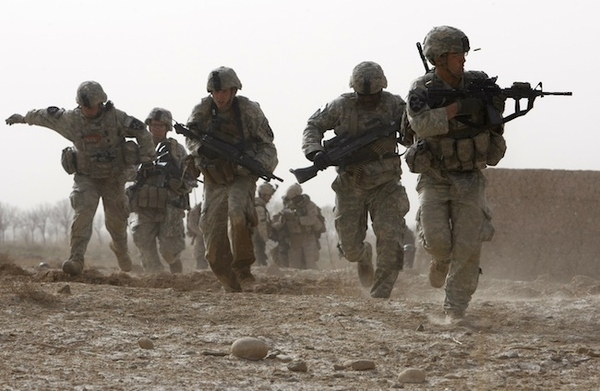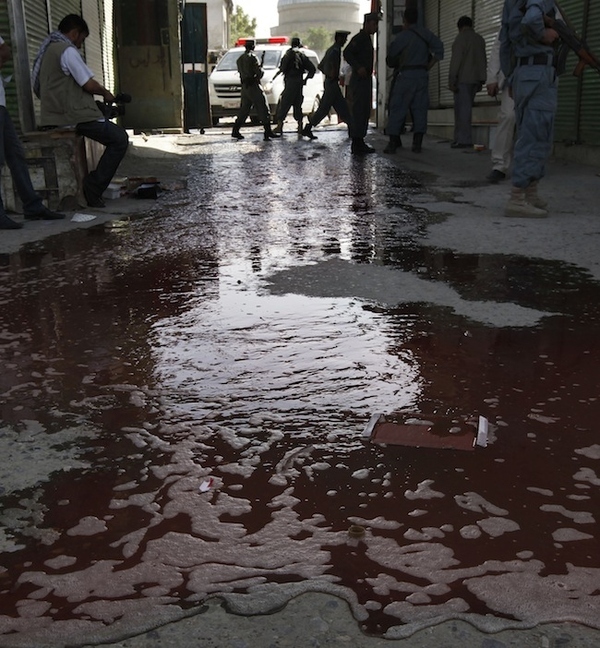President Obama To Pull Troops Out Of Afghanistan At Accelerated Pace
In a speech before the nation, President Obama outlined his plans to reduce U.S. forces in Afghanistan ahead of schedule, removing more than 30,000 troops by the end of next year. 10,000 troops will be home by the end of this year, and another 23,000 will return by September of 2012.
-

In this June 15, 2011 file photo, President Barack Obama speaks in Pensacola, Fla. (AP Photo/Charles Dharapak, File) WASHINGTON (AP)--Pulling home the Americans he sent to war, President Barack Obama announced Wednesday night the withdrawal of more than 30,000 troops from Afghanistan by the end of next summer, hastening the end of the long conflict that has been more costly than ever envisioned when launched in response to the 2001 attacks on America. In an address to the nation, Obama said that he is withdrawing 10,000 troops by the end of this year, and more than 20,000 in addition no later than September 2012. That accounts for all of the extra forces he ordered to Afghanistan in late 2009 to turn around a flailing war effort. The fast-paced drawdown, at a time when the public has turned against the war, will be complete just months before he goes before voters in his bid for a second term. Still, it will leave some 70,000 U.S. troops in unstable Afghanistan in a war bound to see more American lives lost. The United States and its NATO allies hope to end the combat mission and fully turn over control to Afghan forces by the end of 2014, a transition period that may finally bring the war to an end.
-
-

In a Feb. 14, 2010 file photo, a U.S. soldier returns fire as others run for cover during a firefight with insurgents in the Badula Qulp area, west of Lashkar Gah in Helmand province, southern Afghanistan. President Barack Obama will withdraw roughly 10,000 U.S. troops from Afghanistan this year, with one brigade of about 5,000 forces leaving this summer and a second brigade of similar size coming home by the end of the year. (AP Photo/Pier Paolo Cito,File) Obama is under mounting political pressure to wind down the war, especially since Osama bin Laden, the man considered to be the face of it, is dead. U.S. forces found and killed the al-Qaida leader in Pakistan in May, a significant blow to an organization that nevertheless still threatens the United States. At least 1,500 members of the U.S. military have died and 12,000 have been wounded since the U.S. invasion of Afghanistan in late 2001. The financial cost of the war has passed $440 billion and is on the rise given the heavy troop commitment, jumping to $120 billion a year, twice the total of two years ago. The decision to start withdrawing forces in July amounts to a pledge kept by Obama. Yet the scope and pace of the drawdown have been hotly debated. The military lobbied for a more modest troop reduction and Obama promised a significant one as support for the war by the country and Congress faded. The initial withdrawal is expected to happen in two phases, with 5,000 troops coming home this summer and an additional 5,000 by the end of the year, a senior U.S. defense official said. In total, Obama announced the withdrawal of 33,000 troops. That's the 30,000 he announced he was sending in an address in December 2009, plus an extra 3,000 he authorized Defense Secretary Robert Gates to employ to support the effort.
-

An Army carry team moves a transfer case containing the remains of Pfc. Joshua L. Jetton Wednesday, June 22, 2011 at Dover Air Force Base, Del. According to the Department of Defense, Jetton, of Sebring, Fla., died while supporting Operation Enduring Freedom. (AP Photo/Steve Ruark) For Obama, the goal was to explain a stay-the-course moment of progress to the American people the U.S. is not yet leaving Afghanistan without the trappings of a major war address. He was speaking from the all-purpose East Room, not the Oval Office, and he spoke for about 14 minutes, half the time he spent when he announced the troop surge almost 19 months ago. Obama is arguing that the reinforcements he sent have accomplished their mission: eroding the capacity of Taliban insurgents and providing time and training for Afghanistan's forces to get ready to lead their own country. The United States remains in Afghanistan primarily to keep it from becoming a haven for al-Qaida, the terrorist network that based training operations there before launching the worst attacks on American soil on Sept. 11, 2001. Obama's ultimate goal is to defeat al-Qaida. Most Americans oppose the war in Afghanistan and are far more concerned about the teetering economic recovery at home. A new AP-GfK poll out Wednesday found that Obama's approval rating on handling Afghanistan dipped to 52 percent, falling 13 points from its high of 65 percent in May just after the death of bin Laden. In Afghanistan on Wednesday, the nation's Defense Ministry said the NATO-trained military was ready to take responsibility for fighting Taliban insurgents and securing key parts of the country. Many Afghans are eager to see the Americans leave, yet there are big risks for the government there. "There will be some battles, there will be suicide attacks and bomb attacks," acknowledged Defense Ministry spokesman Gen. Mohammad Zahir Azimi. "But we in the Afghan forces are prepared to replace the foreign forces, and I'm confident the army has enough capacity and ability." The president reached his withdrawal decision a week after receiving a range of options from Gen. David Petraeus, the top U.S. and NATO commander in Afghanistan. "The president is commander in chief," spokesman Jay Carney said. "He is in charge of this process, and he makes the decision."
-

Water mixed with blood pours in a steady stream following a suicide bomb attack at the entrance to a police station, in Kabul, Afghanistan, Saturday, June 18, 2011. Men dressed in Afghan army uniforms stormed the police station near the presidential palace and opened fire said Mohammed Honayon, an eyewitness. President Hamid Karzai said Saturday that Afghanistan and the United States are engaged in peace talks with the Taliban, even as insurgents stormed this police station killing three people. (AP Photo/Gemunu Amarasinghe) The administration has begun briefing NATO allies on its plans. British Prime Minister David Cameron's office confirmed that officials there have been informed but declined to offer comment, or to make any immediate statement on the plans for about 9,500 British forces in Afghanistan. A reduction this year totaling 10,000 U.S. troops would be the rough equivalent of two brigades, which are the main building blocks of an Army division. It's not clear whether Obama's decision would require the Pentagon to pull out two full brigades or, instead, withdraw a collection of smaller combat and support units with an equivalent number of troops. If Obama leaves the bulk of the 30,000 surge contingent in Afghanistan through 2012, he will be giving the military another fighting season in addition to the one now under way to damage Taliban forces before a larger withdrawal gets started. It also will buy more time for the Afghan army and police to grow in numbers and capability. Some U.S. military commanders have favored a more gradual reduction in troops than Obama is expected to announce Wednesday night, arguing that too fast a withdrawal could undermine the fragile security gains. But other advisers have backed a more significant withdrawal that starts in July and proceeds steadily through the following months. That camp cites the slow yet steady improvements in security, combined with the killing of bin Laden and U.S. success in dismantling much of the al-Qaida network in the country. On Capitol Hill, even the more moderate or conservative members of Obama's party, such as Sens. Bob Casey of Pennsylvania and Joe Manchin of West Virginia, are pressing for significant cuts and a shift in mission. Obama aides have sidestepped questions about what role the cost of the war played in Obama's decision, saying only that the president was focused on meeting the goal of transferring security by 2014. Following the announcement on the drawdown, Obama will visit troops Thursday at Fort Drum, the upstate New York Army post that is home to the 10th Mountain Division, one of the most frequently deployed divisions to Afghanistan.
